How to clean and descale a Kettle
We rarely “decrumb” the toaster, clean the inside of the microwave or fridge.
Electric devices should work – after all, you paid good money for them.
What we forget is the fact that cleanliness is not about functionality. It is about hygiene.
It cannot be healthy when the bottom of your toaster develops a flourishing biotope and the inside of your fridge’s vegetable drawer is starting to grow legs.
Hygiene is especially crucial when water is involved. It is the source of life, but you want your kettle to produce clean water and not some primordial soup.
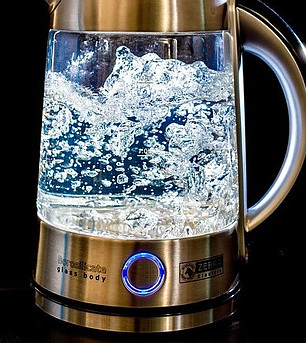
How to keep your kettle clean?
There are a few things you can and should do:
1. Always use fresh water.
Always discard leftovers from the last boil.
2. Empty the kettle overnight and leave the lid open to dry it out.
Never leave water in the kettle when you go on holidays.
3. Clean and disinfect frequently.
Wipe the kettle with a cloth dry, for example, before you go on holidays.
Disinfect with natural products and never with bleach or harsh chemicals. Suitable, efficient and gentle are lemon and vinegar-based cleaners.
The descaling solution given below also works very well to disinfect and clean your electric tea kettle.
For the outside, you can use a regular cleaning spray applied with a damp cloth.
4. Descale your kettle regularly.
More than 85% of American households have hard water coming out of their taps.
Limescale is a mineral deposit (calcium carbonate) abundant in hard water. When the water evaporates, the calcium carbonate crystallizes as a white, hard layer on the inside of kettles, pipes, washing machines, boilers and on your water taps.
The limescale is responsible for the “skin” on tea and coffee caused by the water’s high surface tension.
To break the tension, you need more shampoo for your hair or more detergent for the washing machine than in soft water areas.
Rule of thumb:
The softer the water, the better.
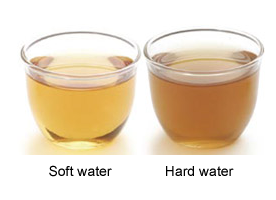
Here is another rule of thumb:
The harder the water, the more descaling is needed.
5. Use only natural ingredients
Since limescale is an alkaline salt, you need an acidic solution to dissolve it.
Therefore vinegar, lemon or citric acid work very well (so does cola, by the way, but not recommended, though).
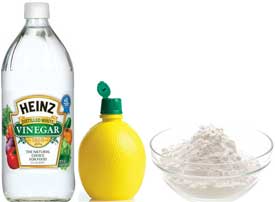
To prevent the build-up of limescale, treat your variable kettle with the following solution:
- Mix 2 parts vinegar (or lemon juice, citric acid) with 1 part water.
- Fill the kettle only half full and bring to a boil.
- Let the water slightly cool down and discard.
- Re-fill with clean water, boil and discard.
- Rinse and repeat until the kettle smells clean and all traces of limescale have been dissolved.
If you have already a persistent layer of white salt in the kettle, use the following, stronger solution:
- Mix equal amounts (1:1) of vinegar with water.
- Fill the kettle and bring it to a boil.
- Let it stand for a few hours or overnight.
- Empty kettle and boil with water.
- Rinse and repeat until all traces and smell of vinegar are gone.
The hot rinsing water is also very beneficial for your drains.
Sometimes not all limescale is dissolved, and you still have some white stuff at the bottom of your kettle.
Once treated with the acidic solution, the limescale gets flaky, and you can carefully scrape it off the bottom.
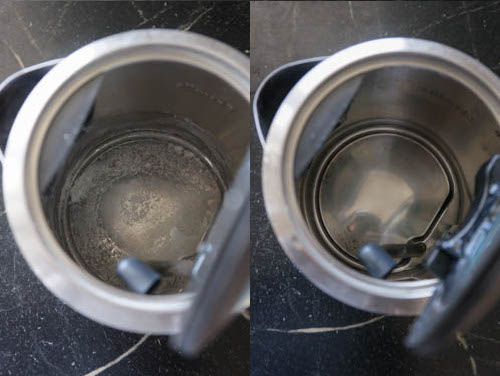
What not to use
Do not use an industrial descaler intended for washing machines or dishwashers in your lovely and possibly expensive programmable kettle.
Natural, food-safe products are easy to find.
Bleach is not food-safe and, due to its highly alkaline nature, would not work anyway.
We also don’t recommend hard, steel brushes to clean the inside.
When cleaning or descaling your kettle, never fill it to the maximum.
When boiled, the solution will foam, spill out and leave an unwelcome mess on your kitchen counter.
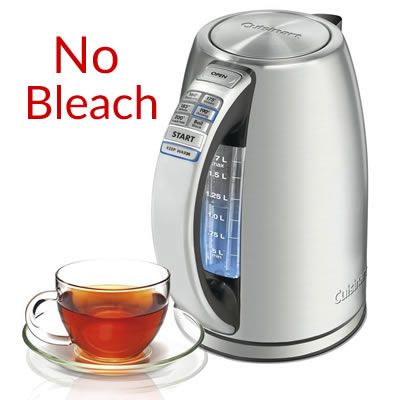
Last Thoughts
To prevent limescale in the first place, you could use filtered or bottled water.
Highly recommended for tea, coffee, and (baby) food.
Besides the hygienic reasons, a clean kettle is also more energy-efficient. The chalky layer of limescale absorbs energy when heating, and therefore, you need more electricity to bring the water to the right temperature.
The same applies to all other household devices.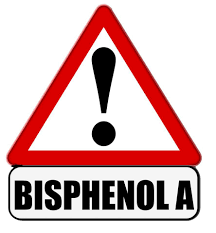
When talking about kettle hygiene, I want to point out the plastic issue again. The inside of some variable temperature kettles is made from heat-resistant plastic, BPA (Bisphenol A, more info here). Research suggests that some small plastic particles can leach into the hot water and pose a health threat.
Third and last rule of thumb:
The less plastic involved, the better.
You can control the water’s pureness but not what might leak into the water from the plastic.
A cleaner device will lead to cleaner water and better tasting teas and coffees.
Your kettle will thank you, not with hugs and birthday cards but with clean water and longer life.
The Kettle Whistler
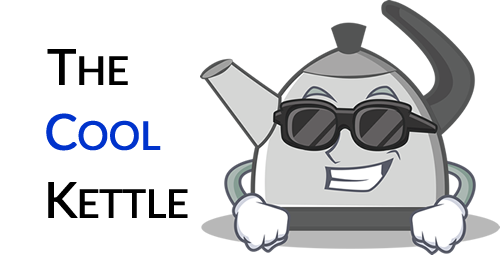
11 Comments
kettle whistler
Please leave your comments below.
Cian Dreamer
Very useful information about how to maintain a good kettle hygiene at home! didn't pay attention to those stuff and your provide a clear guideline on how to clean up the old kettle! So we don't have to buy a new kettle the first place! This is the solution we want to here before buying a new one!
kettle whistler
Thanks Cian. Long live the kettle!
Paul
Your logo is so cool. I like it, It's on point. When I visit your site, I've already guess your niche which is about kettle and the likes. This is the first time I saw a site that is not so colorful and background is mostly white. For me it's unique and I like it. This by far will stand-out because of the uniqueness of your site. Simple and yet catchy to the viewers. The only thing I don't like in your home page is that the space on the right side is too big. It has a big gap. Also your content/articles are too short, probably you can add more reviews, history of the product etc... to make it a bit longer.
Overall, your site is very unique and I like it. Have a nice day!
kettle whistler
Thank you for your comments. In an Internet world where things are constantly flashing at you, I am trying to create a clean and distraction-free environment.
I will take your critical points and suggestions on board. People usually are not critical enough and in doing so promote mediocrity.
Martin
Ben Kuriger
I love your cleaning tips for the kettles. in western society, it is so common to see the use of harsh cleaners and solutions that are not only harmful to the appliance, but are harmful in many ways to the human body and bacterial ecosystem. It is truly sad to see. I personally love using lemon essential oils in combination with other natural cleaners. I love your recommendation.
A lot in here that I learned from. Awesome practical guide on hygiene maintenance for the kettle!
kettle whistler
Thanks Ben. You are absolutely right, lemon juice is a powerful natural cleaner and it smells good too.
Martin
Adyns68
Hi dear
I did not know how to really clean my kettle. What I usually do is, put some liquid soap with water. Let it boil and clean with water. But it's never totally clean. So, I am very glad to read your post. I will never use liquid soap again but only vinegar or the alternative given in the post. And any vinegar will do, right?
And yes, I agree with you that sometimes we don't take care of our electronics but we just suppose, that they will always work. Now we need to change and make sure that, they do work to keep us healthy.
Thanks for sharing!
kettle whistler
I like to be called dear - thank you.
Any vinegar will do. I even used Sushi vinegar (yes, it does exits) one time because I had nothing else to hand.
Martin
Jannatul Ferdaus
Hi, I have read your article very carefully. After reading your article, I found out that you discussed about how to clean a variable temperature kettle. I think this is very informative and helpful post. Thanks for writing this wonderful reviews. Using this simple methods listed above can help us maintain our electric kettle and keep it working and looking like brand new.It is also healthier for our family as well to maintain a clean kettle. TO keep our kettle hygiene, we should follow some simple steps.I like your opinion very much. Thank you very much for sharing this post.
kettle whistler
Thank you for your comment.